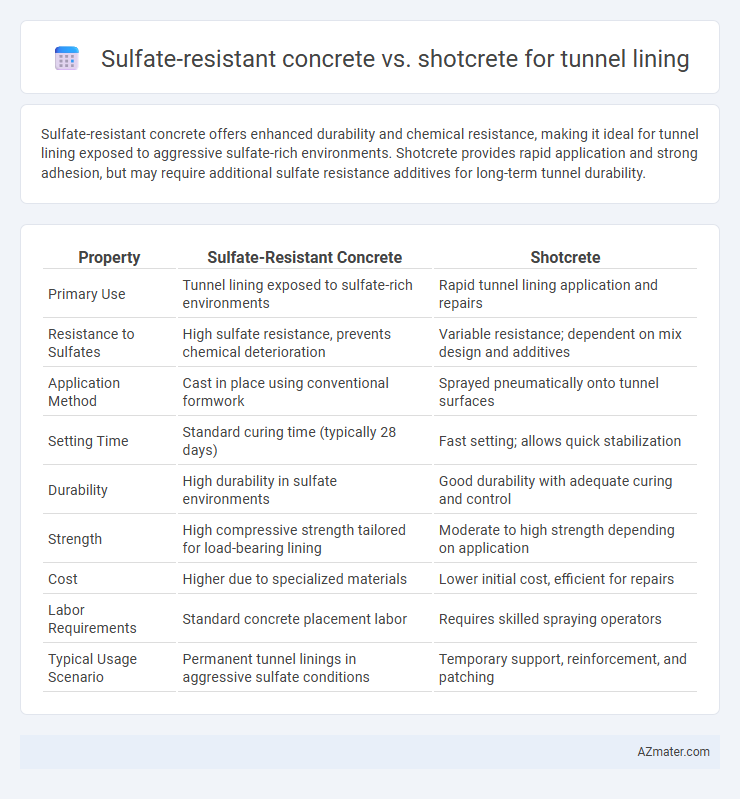Sulfate-resistant concrete offers enhanced durability and chemical resistance, making it ideal for tunnel lining exposed to aggressive sulfate-rich environments. Shotcrete provides rapid application and strong adhesion, but may require additional sulfate resistance additives for long-term tunnel durability.
Table of Comparison
| Property | Sulfate-Resistant Concrete | Shotcrete |
|---|---|---|
| Primary Use | Tunnel lining exposed to sulfate-rich environments | Rapid tunnel lining application and repairs |
| Resistance to Sulfates | High sulfate resistance, prevents chemical deterioration | Variable resistance; dependent on mix design and additives |
| Application Method | Cast in place using conventional formwork | Sprayed pneumatically onto tunnel surfaces |
| Setting Time | Standard curing time (typically 28 days) | Fast setting; allows quick stabilization |
| Durability | High durability in sulfate environments | Good durability with adequate curing and control |
| Strength | High compressive strength tailored for load-bearing lining | Moderate to high strength depending on application |
| Cost | Higher due to specialized materials | Lower initial cost, efficient for repairs |
| Labor Requirements | Standard concrete placement labor | Requires skilled spraying operators |
| Typical Usage Scenario | Permanent tunnel linings in aggressive sulfate conditions | Temporary support, reinforcement, and patching |
Introduction to Tunnel Lining Materials
Sulfate-resistant concrete and shotcrete are essential materials for tunnel lining, each offering distinct benefits in durability and application. Sulfate-resistant concrete is specially formulated to withstand aggressive sulfate environments, preventing chemical degradation and ensuring long-term structural integrity. Shotcrete provides rapid application and excellent adhesion to irregular surfaces, making it ideal for complex tunnel shapes and reinforcing rock faces during excavation.
Understanding Sulfate-Resistant Concrete
Sulfate-resistant concrete is specifically formulated to withstand aggressive sulfate environments often encountered in tunnel lining applications, using low C3A cement and supplementary cementitious materials like fly ash or slag to minimize sulfate attack. Its dense microstructure and chemical composition prevent expansion, cracking, and deterioration caused by sulfate ions, ensuring long-term durability and structural integrity. Compared to shotcrete, which is typically sprayed and may require additional measures for sulfate resistance, sulfate-resistant concrete provides enhanced protection and longevity in high-sulfate underground conditions.
Overview of Shotcrete in Tunnel Construction
Shotcrete is a sprayed concrete method widely used in tunnel lining for its rapid application and excellent adhesion to irregular surfaces, enhancing structural stability during excavation. It offers high early strength and effective sealing against water ingress, making it suitable in sulfate-rich environments where corrosion resistance is critical. Compared to sulfate-resistant concrete, shotcrete adapts better to complex geometries and provides immediate support, but may require additional protective layers to improve long-term sulfate durability.
Chemical Resistance: Sulfate Attack in Tunnels
Sulfate-resistant concrete (SRC), formulated with low C3A cement and supplementary cementitious materials like fly ash or slag, offers superior chemical resistance against sulfate attack, preventing expansion and cracking in tunnel linings exposed to aggressive groundwater. Shotcrete, although versatile and effective for rapid application, typically lacks the precise sulfate-resistant composition of SRC, making it more susceptible to chemical degradation in sulfate-rich environments. Selecting SRC for tunnel linings ensures enhanced durability and longevity by mitigating sulfate-induced deterioration, critical for maintaining structural integrity in subterranean constructions.
Installation Methods: Cast-in-Place vs. Sprayed Applications
Sulfate-resistant concrete for tunnel lining is typically installed using cast-in-place methods that ensure dense, durable walls capable of withstanding aggressive sulfate environments. Shotcrete, applied by spraying, offers faster placement and improved adhesion to irregular surfaces, making it ideal for complex tunnel geometries but may require careful control to maintain sulfate resistance. The choice between cast-in-place sulfate-resistant concrete and sprayed shotcrete depends on project specifications, site conditions, and required durability against sulfate attack.
Durability and Longevity Comparisons
Sulfate-resistant concrete offers enhanced chemical durability by withstanding aggressive sulfate environments, significantly reducing deterioration risks in tunnel linings exposed to sulfate-rich groundwater. Shotcrete provides rapid application and excellent initial bond strength but may be more susceptible to long-term chemical attack unless formulated with sulfate-resistant additives. In terms of longevity, sulfate-resistant concrete typically delivers superior service life with lower maintenance costs, making it preferable for tunnels in highly sulfate-laden conditions.
Structural Performance and Load Bearing
Sulfate-resistant concrete offers enhanced durability and chemical stability in aggressive sulfate environments, ensuring long-term structural performance for tunnel linings exposed to sulfate-rich soils or groundwater. Shotcrete provides excellent adhesion and rapid application, facilitating quick load-bearing support during tunnel excavation but may require reinforcement for sustained structural integrity under heavy loads. Combining sulfate-resistant concrete with shotcrete techniques can optimize tunnel lining performance by balancing chemical resistance and immediate mechanical strength.
Cost Implications and Project Timelines
Sulfate-resistant concrete offers enhanced durability in aggressive soil conditions, reducing long-term maintenance costs but typically involves higher upfront material expenses compared to traditional shotcrete. Shotcrete provides faster application and setting times, which can significantly accelerate tunnel lining schedules and reduce labor costs on short-term projects. Balancing immediate budget constraints with long-term durability needs is crucial when deciding between sulfate-resistant concrete and shotcrete for tunnel lining costs and timelines.
Environmental Considerations and Sustainability
Sulfate-resistant concrete offers enhanced durability in aggressive sulfate-rich environments, reducing the need for repairs and extending tunnel lifespan, which contributes to lower environmental impact through resource conservation. Shotcrete provides rapid application and adaptability to complex tunnel geometries but may require higher cement content, potentially increasing its carbon footprint compared to sulfate-resistant mixes engineered for sustainability. Choosing sulfate-resistant concrete over shotcrete can lead to improved long-term sustainability by minimizing rehabilitation frequency and leveraging optimized mix designs that reduce CO2 emissions and enhance material efficiency in tunnel lining projects.
Choosing the Right Solution for Tunnel Linings
Sulfate-resistant concrete offers enhanced durability in aggressive environments with high sulfate exposure, making it ideal for tunnel linings subject to chemical attack. Shotcrete provides flexibility and rapid application, allowing for effective reinforcement in irregular or complex tunnel geometries. Selecting between sulfate-resistant concrete and shotcrete depends on the tunnel's exposure conditions, structural requirements, and construction timeline.

Infographic: Sulfate-resistant concrete vs Shotcrete for Tunnel lining
 azmater.com
azmater.com